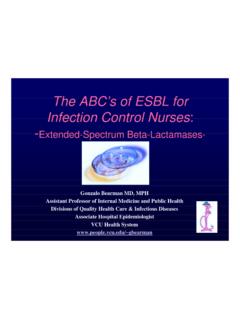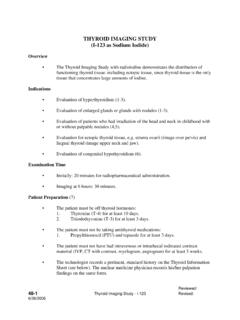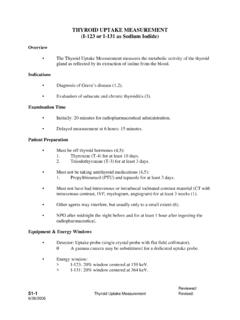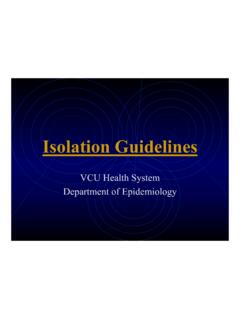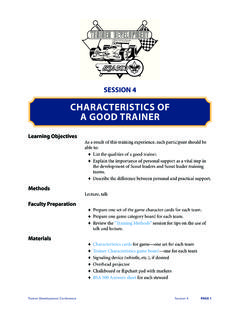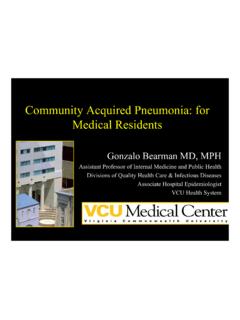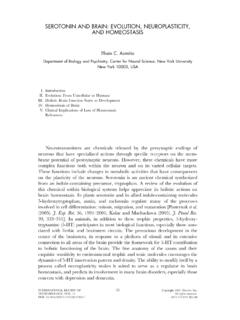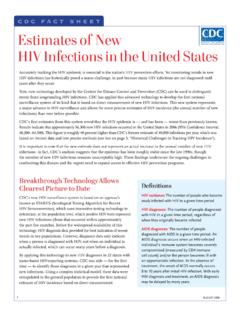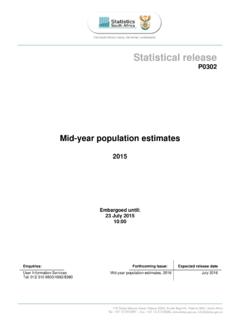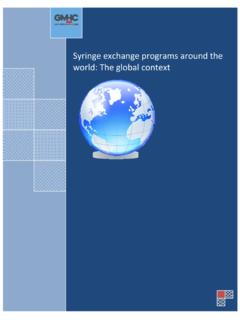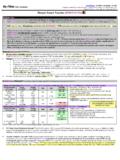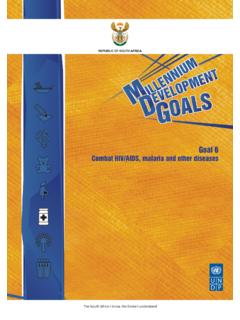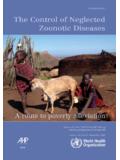Transcription of Prognosis - Virginia Commonwealth University
1 PrognosisGonzalo Bearman MD, MPHA ssociate Professor of Medicine, Epidemiology and Community HealthAssociate Hospital EpidemiologistVirginia Commonwealth UniversityVCU School of MedicineM1 Population Medicine ClassThe physician who cannot inform his patient what would be the probable issue of his complaint, if allowed to follow its natural course, is not qualified to prescribe any rational treatment for its 460-375 BCExtent and determinants of error in doctor s prognoses in terminally ill patients: prospective cohort studyChristakis N, Lamont E. BMJ. Vol and determinants of error in doctors' prognoses in terminally ill patients: prospective cohort study Objective To describe doctors' prognostic accuracy in terminally ill patients Prospective cohort study in five outpatient hospice programs in Chicago Participants 343 doctors provided survival estimates for 468 terminally ill patients at the time of hospice referralChristakis N, Lamont E.
2 BMJ. Vol and determinants of error in doctors' prognoses in terminally ill patients: prospective cohort study Cohort Five outpatient hospice programs in Chicago in 1996 Referring doctors were contacted and administered a four minute telephone survey Estimate of how long the patient had to live Additional data collected Patient demographic, diagnoses Physician specialty, years in practice, and board certification from public records. Dates of patients' deaths obtained from public death registries or the hospicesChristakis N, Lamont E. BMJ. 2000 February 19; 320(7233): 469 473 Extent and determinants of error in doctors' prognoses in terminally ill patients: prospective cohort studyMedian Survival24 daysAccurate Prediction20% (92/468)Over-optimistic63% (295/468)Over-pessimistic17% (81/468) Physicians overestimated survival by a factor of Few patient or doctor characteristics were associated with prognostic accuracyChristakis N, Lamont E.
3 BMJ. 2000 February 19; 320(7233): 469 versus observed survival in 468 terminally ill hospice patients. Diagonal line represents perfect prediction. Patients above diagonal are those in whom survival was overestimated; patients below line are those in whom survival was underestimatedChristakis N, Lamont E. BMJ. 2000 February 19; 320(7233): 469 473 Extent and determinants of error in doctors' prognoses in terminally ill patients: prospective cohort study Doctors are inaccurate in their prognoses for terminally ill patients The error is systematically optimistic The prognostic inaccuracy is, in general, not restricted to certain kinds of doctors or patients This may be adversely affecting the quality of care given to patients near the end of lifeChristakis N, Lamont E. BMJ. 2000 February 19; 320(7233): 469 473 Commentary: Prognoses should be based on proved indices not intuition The accurate prediction of survival is important for several reasons.
4 Excessive optimism may cause us to wait too long to refer people for palliative care, we may delay the use of narcotic drugs for pain relief, and we may persist in unpleasant and pointless treatments aimed at curing or prolonging life when it would be kinder to stopChristakis N, Lamont E. BMJ. 2000 February 19; 320(7233): 469 473 Commentary: Prognoses should be based on proved indices not intuition In the long term it may be possible to extract from the research those criteria that will enable us to make more reliable clinical predictions. Until that time arrives we would do better to stop guessing and, when predictions are needed, to make use of these N, Lamont E. BMJ. 2000 February 19; 320(7233): 469 473 Doctors' prognostic estimates are a central element of both patient and physician decision making, especially at the end of lifeHow can medicine scientifically address the issue of Prognosis such that both physicians and patients are better informed?
5 Studies of PrognosisDisease OnsetRisk FactorsOutcomesMorbidityMortalityRecover yPrognostic factors for outcomeStudy Types Case control studies Cohort studiesElements of Prognostic Studies Population based Representative sample of people afflicted with a disease Unbiased Zero time Time of onset of disease or symptoms Must be well defined Onset or inception of disease Participants should all be enrolled and observed from the same time Maximizes precisionElements of Prognostic Studies Follow up Appropriate length of follow up depends upon the disease and anticipated outcomes Patients must be followed long enough for the clinically important outcome events to occur Inadequate follow up time Observed rate of a given outcome will likely underestimate it s true rateImportant Definitions Clinical course The evolution ( Prognosis ) of a disease has come under medical care and has been treated in a variety of ways that affect the subsequent course of events Natural History The evolution ( Prognosis ) of disease without medical interventionRisk vs.
6 Prognostic FactorsRisk factorsPrognostic factorsPatient PopulationHealthy PopulationSick PopulationOutcomeDisease onsetMorbidityMortalityRatesRare eventRelatively frequent eventsRisk and Prognostic FactorsFletcher and Fletcher. Clinical Lippincott, Williams and Wilkins, of Disease: The 5 D s Important Clinical Outcomes of Concern: Death Disease Discomfort Disability DissatisfactionImportant Rates Used to Describe Prognosis 5 year survival: percent of patients surviving 5 years from some point in the course of their disease Case fatality: percent of patients with a disease who die with it Disease-specific mortality:number of people per 100,000 population dying of a specific disease Important Rates Used to Describe Prognosis Response: percent of patients showing a clinical improvement following a therapeutic intervention Remission: percent of patients entering a phase in which disease is no longer detectable Recurrence.
7 Percent of patients entering a phase in which disease is no longer undetectableSome real life 1 63 year old Caucasian man HTN and DM Palpable abdominal mass confirmed by CT scan AAA 8 cm in size What is his Prognosis ?Rupture rate of large abdominal aortic aneurysms in patients refusing or unfit for elective repair Background: Among patients with abdominal aortic aneurysm (AAA) who have high operative risk, repair is usually deferred until the AAA reaches a diameter at which rupture risk is thought to outweigh operative risk Few data exist on rupture risk of large AAA Objective: To determine the incidence of rupture in patients with large AAAL ederle FA et al. JAMA. 2002 Jun 12;287(22):2968-72 Rupture rate of large abdominal aortic aneurysms in patients refusing or unfit for elective repair Method and Outcomes Prospective cohort study in 47 Veterans Affairs medical centers Veterans (n = 198) with AAA of at least cm for whom elective AAA repair was not planned because of medical contraindication or patient refusal Incidence of AAA rupture by strata of initial and attained diameterLederle FA et al.
8 JAMA. 2002 Jun 12;287(22):2968-72 Lederle, F. A. et al. JAMA 2002;287 Incidence of Probable Rupture by Attained AAA DiameterRupture rate of large abdominal aortic aneurysms in patients refusing or unfit for elective repair Conclusion The rupture rate is substantial in high-operative-risk patients with AAA of at least cm in diameter and increases with larger diameterLederle FA et al. JAMA. 2002 Jun 12;287(22):2968-72 Case 2 23 year oldAA woman, IVDA Admitted to the hospital for bacterial pneumonia. Diagnosed with HIV What is her Prognosis ? When should HIV therapy be started?Time Course of HIV Infection:Immunological and Virological MarkersHIV RNAHIV Cx TiterCD4 MACS cohort, Mellors,et al. Ann Intern Med 1997;126:946 When To Start Treatment? Summary of Current GuidelinesGuidelinessymptoms orCD4 <200CD4 200-350CD4 >350 DHHS:7/14/03 update < >treatoffer treatmentdefer if VL <55K; treat or defer if VL >55 KIAS-USA:JAMA 2002treatconsidertreatmentconsider if VL >50-100 KCase 3 87 year old caucasian man HTN Recently admitted for an ischemic stroke Will the addition of lipid lowering therapy affect Prognosis ?
9 High-Dose Atorvastatin after Stroke or Transient Ischemic Attack Statins reduce the incidence of strokes among patients at increased risk for cardiovascular disease Whether they reduce the risk of stroke after a recent stroke or transient ischemic attack (TIA) remains unknownAmarenco P. et al. Aug 10;355(6):549-59 High-Dose Atorvastatin after Stroke or Transient Ischemic Attack Method 4731 patients with prior stroke or TIA within one to six months before study entry and no known coronary heart disease Randomly assigned to double-blind treatment with 80 mg of atorvastatin per day or placebo. Primary end point- first nonfatal or fatal strokeAmarenco P. et al. Aug 10;355(6):549-59 Amarenco P. et al. Aug 10;355(6):549-59 Stroke or TIAA marenco P. et al. Aug 10;355(6):549-59 Cardiovascular EventsHigh-Dose Atorvastatin after Stroke or Transient Ischemic Attack Conclusion In patients with recent stroke or TIA and without known coronary heart disease, 80 mg of atorvastatin per day reduced the overall incidence of strokes and of cardiovascular eventsAmarenco P.
10 Et al. Aug 10;355(6):549-59 Clinical Prediction Rules Prediction rules estimate the probability of outcomes according to a set of patient characteristics Outcomes include Morbidity, mortality, adverse events etcClinical Prediction Rules Clinical prediction ruleis type of medical research study in which researchers try to identify the best combination of medical sign, symptoms, and other findings in predicting the probability of a specific disease or outcomeClinical Prediction Rules Investigators identify a consecutive group of patients who are suspected of a having a specific disease or outcome Data collected on signs, symptoms, laboratory values etc Logistic regression/multivariate analysis used to develop prediction rule on a cohort retrospectively Prediction rule is then validated prospectively Prediction rules are meant to assist in clinical decision makingPredicting Mortality Among Patients Hospitalized for Heart Failure A predictive model of mortality in heart failuremay be useful for clinicians to improve communication with and care of hospitalized patients Objective: To identify predictors of mortality and to develop and validate a model using information available at hospital presentationLee, D.
